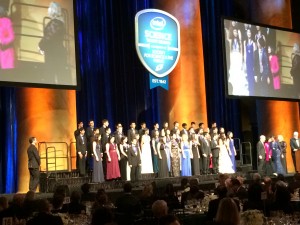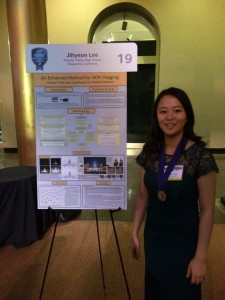
The future is bright for 40 young finalists from Intel’s 2015 Science Talent Search, who as high school seniors are already completing and publishing graduate level science projects.
The Intel Science Talent Search (Intel STS), a program of the Society for Science & the Public, is the nation’s most prestigious pre-college science competition. Alumni of STS have made extraordinary contributions to science and hold more than 100 of the world’s most distinguished science and math honors, including the Nobel Prize and the National Medal of Science. Each year, 300 Intel STS semifinalists and their schools are recognized. From that select pool of semifinalists, 40 student finalists are invited to Washington, DC in March to participate in final judging, display their work to the public, meet notable scientists, and compete for awards, including three top awards of $150,000 each.
This year 19 young women and 21 young men came from 36 schools in 18 states and competed in 17 different categories. There were four projects under the computer science category, including Jihyeon Lee’s project on An Enhanced Method for HDR Imaging: Artifact-Free and Optimized for Mobile Devices.
 Jihyeon (Janel) Lee is from Amador Valley High School in Pleasanton, CA. The Computing Community Consortium (CCC) met with her and we were very impressed by her project, her individual work on her project, and her passion for computer science!
Jihyeon (Janel) Lee is from Amador Valley High School in Pleasanton, CA. The Computing Community Consortium (CCC) met with her and we were very impressed by her project, her individual work on her project, and her passion for computer science!
Janel answered a few questions for us to share her story:
1) Briefly describe your project.
My project was on developing an enhanced algorithm for high dynamic range (HDR) imaging. In HDR imaging, multiple low dynamic range (LDR) images taken at different exposure times are combined to produce one HDR image. Although HDR imaging can create much more vibrant photos that better capture a real world scene, its practical usage is still difficult due to distortions called artifacts, caused by common problems like camera shake and unwanted objects moving through a scene. I developed an algorithm that could detect and remove artifacts (blurring and ghosting, specifically) and also optimized it so that it could be implemented on mobile devices (so that people can actually use this technology in real life!).
2) How long have you been working on your project? Who were your mentors?
I’ve been working on this project close to two years now. I didn’t do my research at a lab or professional institution but worked independently. I would say my mentor would be my dad; he helped me identify some new directions when I was stuck.
3) How did you come up with the project idea?
I was really frustrated with my own phone, which had an HDR imaging feature on it. There was a little warning message that said to be careful not to shake the phone, which definitely bothered me since camera shake is a very common problem among users. I just started Googling about HDR imaging and what steps were being taken to address human error, and when I couldn’t find a solution that satisfied my needs, I decided to develop my own.
4) What are your plans for your project?
There is some possible future work tied with my project that I’m looking into, such as greater optimization and using accelerometers and gyroscopes to calculate rotational movement. I don’t know for sure how long I’ll be working on this project, but it’s definitely helped me decide that computer science is what I want to pursue in the future.
5) What are your plans for the future/ what would you like to do?
I’m not entirely sure yet, but I would like to first major in Computer Science and/or Electrical Engineering in college. There are so many applications of computer science that I’d like to continue doing research in college and hopefully find a field to which I can apply my skills, whether it be business, finance, neuroscience, or something else.
6) Briefly describe the week you spent in DC. What did you do? What did you learn? What was the best part?
It was my first time at our nation’s capital, and we got to go on a tour to see the major monuments and landmarks but also got some time to explore on our own (the powerful atmosphere of the Lincoln Memorial was amazing). There were two days of judging, where we were individually interviewed with questions from any field and any topic. Then, we presented our projects with our boards to the judges and also shared our research with the public on Public Day. I think this was really my favorite part. Having younger students ask me about my project and showing interest in science is awesome, and I hope I convinced them to continue to like computer science!
With exceptional high school students like Janel, we can be confident that research in computer science will continue to produce products and services to enrich our daily lives.









